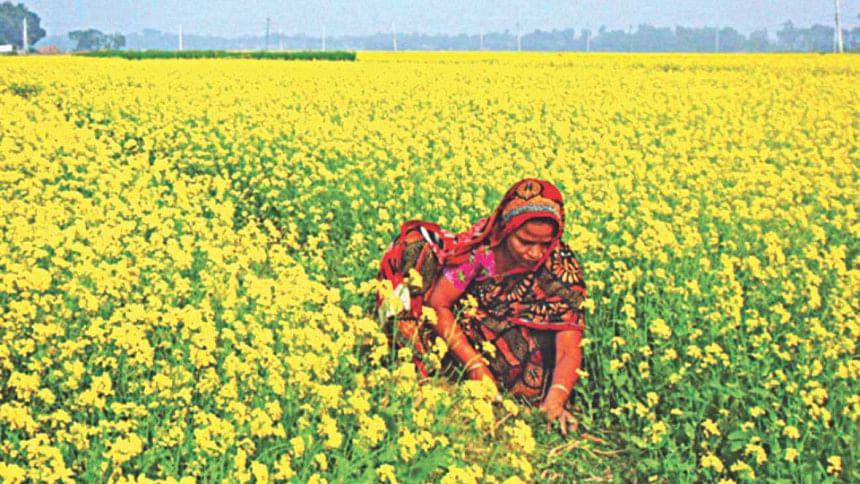Are women better guardians of natural resources?

Although the notion of women being better 'husbands' than their counterparts may seem strange to many men at first, there are solid justifications for this. It is well-known that the root of the word 'husband' is the word 'husbandry', which means taking care of someone or something. Thus, the literal meaning of husband is 'caretaker.' Women continue to play the main role of taking care of the household in most societies – doing all the traditional chores such as taking care of the husbands and children, cooking, washing, cleaning, etc. However, in recent decades, women have stepped into acquiring the main instrument of power at every level – earning money through different forms of gainful employment, although globally, women are paid about half the amount earned by men. What makes them better husbands is reflected in the fact that about 80 cents of a dollar earned by women are invested in family welfare compared to only 30 cents earned by men. In such a discourse, empowerment of women has been a just cause and it continues to remain a prominent global development agenda.
The rapidly changing income or material dimension of power in the household is evident particularly in case of the rural poor. Bangladesh is the living example of promoting women's empowerment through many governmental and non-governmental activities. Microfinance activities figure prominently among them. Many studies have shown that women are better loan re-payers than men. As a result, rural women have become the focus of microfinance activities. A recent study published in the Applied Economics Letters has revealed that an increase in the proportion of women accessing microfinance by just 15 percent could potentially reduce gender inequality, as measured by the Global Inequality Index, by half in the developing countries. Similarly, poor women accessing income generating activities can help address gender inequality; women working in the garment industry in Bangladesh are exemplary in such a case. Cultural characteristics also play a role, such as less time for household chores and freedom to work outside their homes.
However, microfinance did not pay much attention to engaging women in nurturing nature and natural resource-based activities, although women are traditionally linked more to surrounding natural resources for their basic needs, such as fuelwood or water collection. In the past, women did not have much access and control over these resources. Some years ago, a project on Building Environmental Governance Capacity in Bangladesh (BEGCB) funded by Global Affairs Canada (formerly CIDA) under the University Partnership for Capacity Development programme and implemented by the University of Manitoba, North South University, BRAC University and an NGO, Centre for Natural Resource Studies (CNRS), was undertaken. The BEGCB project had an element, carried out by CNRS, of promoting sustainable natural resource management (NRM) through microfinance activities of rural women in haor areas of Moulvibazar and Sylhet. It was found that an unrealised potential of synergy between microfinance operations and NRM programme exists in natural resource-rich areas. Looking for ways in which this potential of women's empowerment and simultaneously nurturing nature could be realised was the central focus of this project component.
For the last few decades millions of small-scale activities undertaken by micro-lenders synergistically had a huge impact on the environment. With such a goal, the CNRS's microfinance component of the project attempted to address several challenges: How can microfinance be used to foster 'green' micro-enterprises that enhance rather than degrade local resources? What are the ways in which one could evaluate whether women-focused activities can provide livelihood improvement without undermining the resource base on which they depend? One of the proposed approaches was to look at the fit between microfinance operations by rural women and ecosystem services. Such questions have been addressed by the teams of the partnered university students, faculty and the CNRS staff.
The outcomes of this component were quite encouraging. Women members of the mobilised groups proved as better 'husbands' of local resources, establishing a culture of their sustainable use, while conserving and improving the quality and quantity of local natural resources. This experience established the practice of 'greening of microfinance', according to a report on MURJ, published by MIT. Field research of few small-scale activities undertaken by Shahidullah and Haque during 2012-2014 revealed that majority of such enterprises are not only sustainable and comply with current ecological standards, but also contribute to generating a number of vital ecosystem services. They also simultaneously maintain reasonably high profit margins, to ensure long-term economic viability. These findings indicate that micro-enterprises, given environmental guidance by developmental NGOs, especially NGO-MFIs, have the potential to make significant ecological contributions and enhance livelihood resilience against the impacts of climate change. Another study by the same authors compared the ecological outcomes of green microfinance-assisted enterprises and traditional microcredit-assisted enterprises and measured their greenhouse gas (GHG) emissions. Cool Farm Tool software was used to quantify GHGs. Comparison in a designed experiment shows that micro-enterprises employing green strategies emit less GHGs than the ones with traditional strategies. The research revealed that the microfinance-based greening interventions help ensure ecological outcomes for micro-enterprises; thus the combination of the embedded economic and social elements of the classic microfinance model with the new ecological elements supports sustainability.This bottom-up, community-based approach needs pump-priming internationally, as well as by the government and civil society groups and NGOs.
In addition, under the BEGCB project activities, local women used the natural nutrients and fertilisers for growing vegetables, which maintained the traditional, pleasing age-old taste of produced crops and vegetables, unlike chemical fertiliser-based production and culture fisheries.The latter process increased biomass but with no taste or flavour. Further, one of the ways of sustainable use of renewable resources was found out to be the implementation of the livelihood diversification options away from those resources; for example, a time-off by the fishers from fisheries during the spawning season. Numerous such options were suggested by the local women members of the project community. The result was impressive: both the quality of fisheries in terms of diversity and their quantity kept increasing, the benefits of which local communities now enjoy – the husbandry of nature is being taken care of by the local women and their networked organisations. Who then are better 'husbands' of households, nature and its resources? The womenfolk.
Mizan R Khan is Professor, Department of Environmental Science and Management, North South University, Bangladesh. C Emdad Haque is Professor, Natural Resources Institute, University of Manitoba, Canada.

 For all latest news, follow The Daily Star's Google News channel.
For all latest news, follow The Daily Star's Google News channel. 



Comments